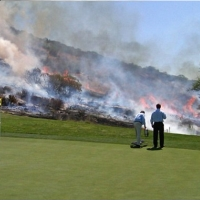Researchers Blame Titanium Clubs for Golf Course Fires

You don’t need to be a professional golfer to burn up the course.
Titanium alloy golf clubs will do nicely, according to researchers at the University of California, Irvine. They determined that golfers swinging their low-density, high-strength clubs set at least two local courses afire when they struck a rock, which threw off sparks on a dry day.
The researchers were asked by the Orange County Fire Authority (OCFA) to check out suspicions that some of its investigators—and a few golfers—had harbored for years. OCFA Captain Steve Concialdi told the Associated Press the report was vindication for those who had been laughed at for supporting the theory.
Researchers specifically took aim at a 2010 fire that burned 25 acres at Irvine's Shady Canyon and a 2011 fire at Arroyo Trabuco Golf Club in Mission Viejo, which burned close to homes. “The common denominator was each golfer used a titanium club, and hit the ball just out of bounds next to dry vegetation where the ground was extremely rocky,” Concialdi said.
But at the time, news reports said golfer claims of club-sparked fires were greeted with skepticism by investigators, who wanted to know if they had been smoking something out on the course. Eventually the fire chief was said to have embraced the titanium sparks theory.
“It might seem funny now (how it happened), but I could have burned down Mission Viejo,” said golfer Steve Parsons, who never doubted he had ignited the blaze when he hit an esposed rock with a 3-iron and found himself surrounded by a ring of fire seconds later.
The researchers re-created the hot dry conditions in the laboratory, broke out the electron microscope and high-speed cameras, and then found that by striking a rock with titanium, they could produce sparks of 3,000 degrees Fahrenheit that burn for more than second. That didn’t happen with stainless steel clubs.
“Titanium reacts violently with both oxygen and nitrogen in the air,” lead author James Earthman, a chemical engineering and materials science professor, told AP. Earthman pointed out the danger did not just come from duffers slamming their clubs into boulders, inadvertently and on purpose.
“Rocks are often embedded in the ground in these rough areas of dry foliage,” he said. “When the club strikes a ball, nearby rocks can tear particles of titanium from the sole of the head. Bits of the particle surfaces will react violently with oxygen or nitrogen in the air, and a tremendous amount of heat is produced. The foliage ignites in flames.”
–Ken Broder
To Learn More:
Study Finds Sparks from Golf Clubs Ignites Fires (by Christopher Weber, Associated Press)
Titanium Clubs Can Cause Golf Course Fires, UCI Study Finds (UC Irvine News)
How Hot Was It at Arroyo Trabuco? (by Randy Youngman, Orange County Register)
Spark Production by Abrasion of Titanium Alloys in Golf Club Heads (by Janahan Arulmoli, Bryant Vu, Ming-Je Sung, Farghalli A. Mohamed, and James C. Earthman, University of California, Irvine)
FIRE! A Leader in the Clubhouse for 2011 Hot List (by Matt Ginella, Golf Digest)
Bad Golf Shot Starts Wildfire (by Noel Brinkerhoff and David Wallechinsky, AllGov)
- Top Stories
- Controversies
- Where is the Money Going?
- California and the Nation
- Appointments and Resignations
- Unusual News
- Latest News
- California Forbids U.S. Immigration Agents from Pretending to be Police
- California Lawmakers Urged to Strip “Self-Dealing” Tax Board of Its Duties
- Big Oil’s Grip on California
- Santa Cruz Police See Homeland Security Betrayal in Use of Gang Roundup as Cover for Immigration Raid
- Oil Companies Face Deadline to Stop Polluting California Groundwater





